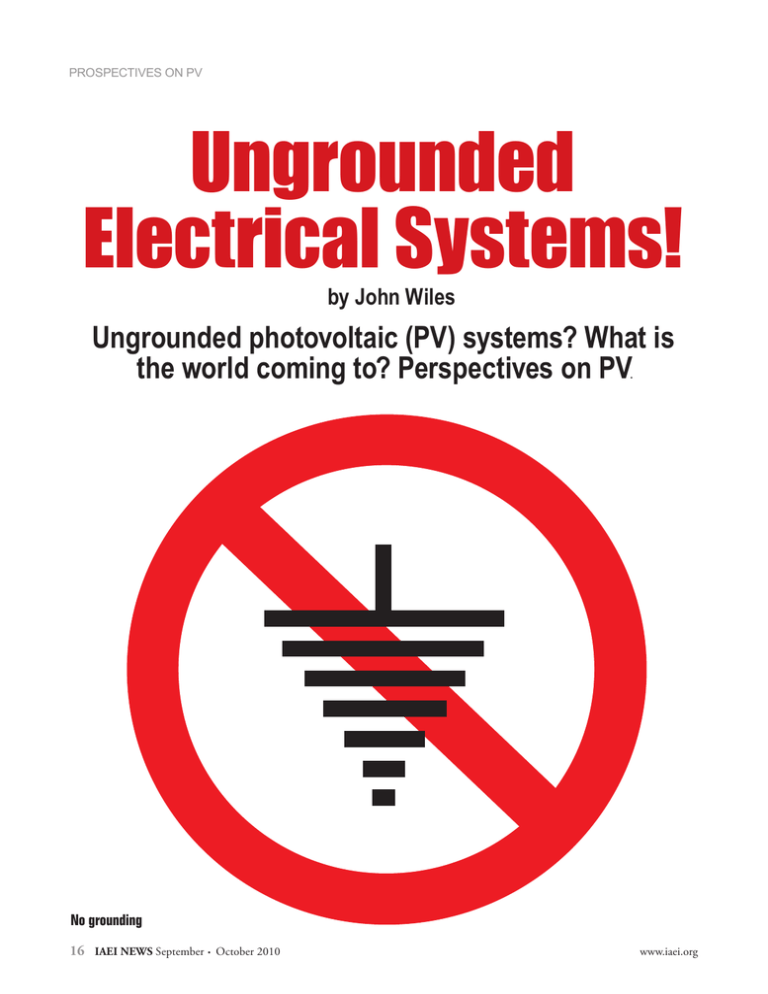Ungrounded Electrical Systems!
advertisement

prospectives on pv Ungrounded Electrical Systems! by John Wiles Ungrounded photovoltaic (PV) systems? What is the world coming to? Perspectives on PV. No grounding 16 IAEI NEWS September . October 2010 www.iaei.org prospectives on pv No transformers A Little History Actually the United States is catching up to the rest of the world, which has, for the most part, been using ungrounded electrical systems for as long as the U. S. has been using grounded electrical systems. More than 100 years ago, the debate on grounded vs. ungrounded electrical systems began and the U. S. went grounded while many other countries went ungrounded. When we discuss grounded vs. ungrounded electrical systems, we are addressing whether one of the circuit conductors, like our ac neutral conductor, is grounded or not. Except for ungrounded three-phase delta-connected transmission and distribution systems, most of our electrical systems in the U. S. have a grounded circuit conductor. In Europe and elsewhere, ungrounded electrical systems are common and, in fact, in Germany, ungrounded three-phase ac power at 230 volts comes directly into the dwellings. www.iaei.org To some extent, most electrical systems in the developed counties use a system of equipment-grounding conductors, called protective earth (PE) in Europe, to provide an outer layer of defense against electrical shocks from exposed conductive surfaces that could become energized. Of course, as in the U. S., double-insulated appliances and tools can be found that do not require an equipment-grounding system. There will be no attempt in this article to further the ages-old debate of the safety of ungrounded vs. grounded electrical systems. Given the history, equipment, training, and experiences on both sides of the issue, it appears that either system can provide equal levels of safety. As the world grows smaller, IEC standards in Europe are being harmonized with the standards developed by Underwriters Laboratories (UL) here in the U. S. and the codes are slowly adopting similar requirements and allowances. September . October 2010 IAEI NEWS 17 prospectives on pv Impact on PV System Design Since the U. S. uses grounded electrical systems, PV systems installed in the U. S. have been required to have a grounded circuit conductor since 1984 when PV requirements first appeared in the National Electrical Code (NEC). From the beginning, PV systems with a maximum systems voltage of 50 volts or below have not required a grounded circuit conductor and in NEC-2005, Section 690.35 was added to the Code to permit the use of ungrounded PV arrays with few voltage restrictions. In utility-interactive PV systems, the inverter can be greatly simplified to a conceptual switching device and a filter with other added control components. Of course, how the utility-interactive inverter actually works is far more complex. The switch reverses the polarity of the dc output from the PV array 120 times per second to generate a 60 Hz waveform that is shaped into a sine wave by the filter. In Europe, they use 100 switches per second to get 50 Hz. Because the European PV arrays and the electrical system are ungrounded, the PV utility-interactive inverter can be relatively simple compared to what is required in the United States. In the U. S., with a grounded circuit conductor from the PV array and a grounded circuit conductor in the ac inverter output circuit, it is not possible to use a direct switching device because the switch would be shorted as it tried to reverse the polarity of the dc circuit into an ac signal. A transformer is required in inverters used in the U. S. to isolate the grounded dc circuits from the grounded ac circuits. The transformer is usually a heavy, costly, and bulky device that decreases efficiency, increases the size, and increases the shipping costs of the inverter. U. S. inverter manufacturers and inverter manufacturers in the rest of the world can now sell transformerless inverters in the U. S. Those inverters must be used with an ungrounded PV array, and the NEC allows such ungrounded PV arrays (see 690.35). Several inverters are on the market now (see photos 1, 2, and 3). What are these systems going to look like to the PV installer and the inspector? The Ungrounded PV System These ungrounded systems are not going to be significantly different from the PV systems that we have been installing and inspecting for many years. They will continue to have a system of equipment-grounding conductors that will connect the module frames, racks, enclosures of combiners, disconnects and inverters together and to ground (earth in Euro-speak). According to NEC 690.35(B), dc overcurrent pro- Photo 1. A 9 kW transformerless inverter by SMA Solar Technologies AG tection (when required for three strings of modules or more) will be required in both of the now-ungrounded circuit conductors. PV source circuit combiners for multiple strings of modules will have overcurrent protection in both the positive and negative dc inputs from each string of modules. The PV dc disconnecting means will be required in both of the ungrounded conductors [690.35(A)]. With disconnects required in each ungrounded circuit conductor, external and internal disconnects will have a switch pole in each of the conductors coming from the PV array. Ampacity calculations will be the same for grounded and ungrounded systems, and the calculations for maximum system voltage will be the same. The color code of white for a grounded conductor will no longer be used; and it is logical that the color code of red for a positive conductor and black for a negative conductor be used, but there is no Code requirement 18 IAEI NEWS September . October 2010 www.iaei.org prospectives on pv Photo 3. A 3.6 kW transformerless inverter by Power One All exposed single-conductor cables including those attached directly to the module must be the new PV Wire or PV Cable made and listed to UL Standard 4703 [690.35(D)(3)]. Installers and inspectors should be aware that some of the European PV Cables, PV Wires or other cables with similar names made for the European market (and even made to UL Standard 4703) may use fine-stranded, flexible conductors and it will be difficult to obtain lugs and terminals suitable for use with these cables where they transition to a conduit wiring method. (See NEC 690. 31(F) and “Perspectives on PV” in the January/February 2005, IAEI News). The inverter must be listed and clearly marked for use with ungrounded PV arrays, and it must have an appropriate internal ground-fault detection and indication system [690.35(C)]. That circuit will not be required to interrupt the ground-fault current (as is required on grounded PV arrays) because on the first ground fault on an ungrounded system, there will be no ground-fault Photo 2. A 5 kW transformerless inverter by Power One currents. The inverter or charge controller will be rethat these colors be used. As before, the module inter- quired to shut down and indicate that a ground fault connecting cable and other short-runs of exposed single has occurred. conductor cables will usually have black insulation (for superior UV resistance) with colored markings used for Summary identification. As an exercise, look at photo 4 and deter- Ungrounded PV arrays, permitted by the NEC, will almine what sort of system is shown. low the use of the new transformerless inverters. Color www.iaei.org September . October 2010 IAEI NEWS 19 prospectives on pv Photo 4. Is it an ungrounded PV source circuit or an improperly color-coded grounded source circuit? A An Update on Microinverters and AC PV Modules s the microinverters, combinations of microinverters attached to PV modules, and the AC PV modules come to market, there will be and already has been some confusion about the code requirements for various products. Both microinverters and microinverters attached to PV modules in the field or in the factory that have any exposed dc single conductor cables are required to meet all of the dc wiring requirements in the NEC. These may include 690.5 ground-fault detector requirements, dc and ac disconnect requirements (potentially handled by connectors listed as disconnects), and inverter dc grounding electrode requirements. Confusion arises when these are called AC modules. They are not AC PV modules. True AC PV modules, as defined in NEC 690.2 and 690.6, have a module and inverter assembled as one environmentally protected unit in the factory, and there is no accessible dc wiring. None of the dc wiring requirements in the Code applies, because there is no dc wiring outside the listed unit. A single equipmentgrounding connection will usually be the only requirement to properly ground the combined module/ inverter assembly. 20 IAEI NEWS September . October 2010 www.iaei.org prospectives on pv codes will no longer require the white conductor. Dis- on this web site: http://www.nmsu.edu/~tdi/Photovoltaconnects will have poles in both the negative and posi- ics/Codes-Stds/Codes-Stds.html tive conductors; and overcurrent devices, where required, The author makes 6–8 hour presentations on “PV will be in both conductors too. Systems and the NEC” to groups of 60 or more inspectors, electricians, electrical contractors, and PV profesFor Additional Information sionals for a very nominal cost on an as-requested basis. If this article has raised questions, do not hesitate to A schedule of future presentations can be found on the contact the author by phone or e-mail. E-mail: jwiles@ IEE/SWTDI web site. nmsu.edu Phone: 575-646-6105 John Wiles works at the Institute for Energy and the See the web site below for a schedule of presentations Environment (IEE) (formerly the Southwest Technolon PV and the Code. ogy Development Institute) at New Mexico State UniA color copy of the latest version (1.91) of the 150versity. IEE has a contract with the US Department of Energy to provide engineering support to the PV induspage, Photovoltaic Power Systems and the 2005 Natry and to provide that industry, electrical contractors, tional Electrical Code: Suggested Practices, written by electricians, and electrical inspectors with a focal point the author, may be downloaded from this web site: for Code issues related to PV systems. He serves as the http://www.nmsu.edu/~tdi/Photovoltaics/Codes-Stds/ secretary of the PV Industry Forum that submitted 54 proposals for the 2011 NEC. He provides draft comments to NFPA for Article 690 in Codes-Stds.html the NEC Handbook. As an old solar pioneer, he lived for 16 years in The Southwest Technology Development Institute a stand-alone PV-powered home in suburbia with his wife, two dogs, web site maintains a PV Systems Inspector/Installer and a cat—permitted and inspected, of course. The PV system on his Checklist and all copies of the previous “Perspectives home is a 5 kW (dc) utility-interactive system with a full-house battery on PV” articles for easy downloading. Copies of “Code back up. Corner” written by the author and published in Home This work was supported by the United States Department of Energy Power Magazine over the last 10 years are also available under Contract DE-FC 36-05-G015149. ONLINE CONTINUING EDUCATION Computer beginner or an expert, we’ve made it EASY! NEC-2008 Analysis of Changes We know how seriously you take your profession, so why not get your continuing education from the people who wrote the book (IAEI has two representatives on each NEC code panel); and get it delivered to your computer by one of the best providers of online electrical code courses? License Renewal Time Florida: by August 31, 2010 Michigan: by December 31, 2010 Texas: by date of licensure IAEI has allied with www.PacePDH.com to bring you complete continuing education technical requirement courses. • Professionally narrated, high-quality visuals • Start and stop according to your schedule • Some of the lowest prices in the industry • Personalized customer care • Sign up in only a few minutes • No endless pages of text • No travel expenses SO510 www.iaei.org Visit: www.PacePDH.com/IAEI or Call: 1-800-576-4341. September . October 2010 IAEI NEWS 21





